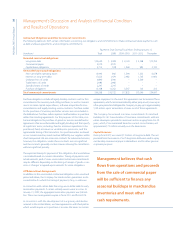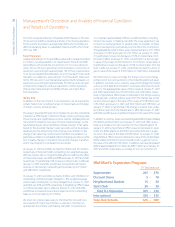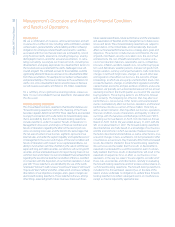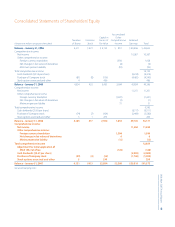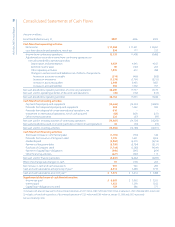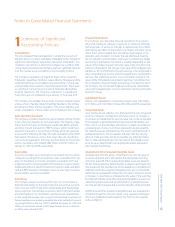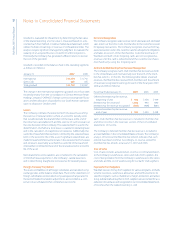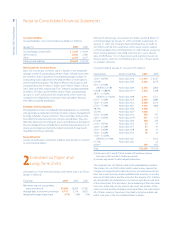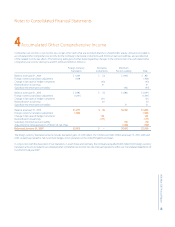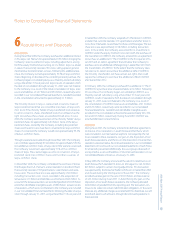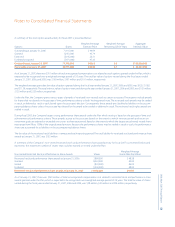Walmart 2007 Annual Report Download - page 45
Download and view the complete annual report
Please find page 45 of the 2007 Walmart annual report below. You can navigate through the pages in the report by either clicking on the pages listed below, or by using the keyword search tool below to find specific information within the annual report.
Wal-Mart 2007 Annual Report 43
1
Summary of Significant
Accounting Policies
Consolidation
The Consolidated Financial Statements include the accounts of
Wal-Mart Stores, Inc. and its subsidiaries (“Wal-Mart” or the “Company”).
Signi cant intercompany transactions have been eliminated in con-
solidation. Investments in which the Company has a 20% to 50%
voting interest and where the Company exercises signi cant in uence
over the investee are accounted for using the equity method.
The Company’s operations in Argentina, Brazil, China, Costa Rica,
El Salvador, Guatemala, Honduras, Japan, Mexico, Nicaragua and the
United Kingdom are consolidated using a December 31 scal year-
end, generally due to statutory reporting requirements. There were
no signi cant intervening events which materially a ected the
nancial statements. The Company’s operations in Canada and
Puerto Rico are consolidated using a January 31 scal year-end.
The Company consolidates the accounts of certain variable interest
entities where it has been determined that Wal-Mart is the primary
bene ciary of those entities’ operations. The assets, liabilities and
results of operations of these entities are not material to the Company.
Cash and Cash Equivalents
The Company considers investments with a maturity of three months
or less when purchased to be cash equivalents. The majority of pay-
ments due from banks for third-party credit card, debit card and
electronic bene t transactions (“EBT”) process within 24-48 hours,
except for transactions occurring on a Friday, which are generally
processed the following Monday. All credit card, debit card and EBT
transactions that process in less than seven days are classi ed as
cash and cash equivalents. Amounts due from banks for these trans-
actions classi ed as cash totaled $882 million and $561 million at
January 31, 2007 and 2006, respectively.
Receivables
Accounts receivable consist primarily of receivables from insurance
companies resulting from our pharmacy sales, receivables from sup-
pliers for marketing or incentive programs, receivables from real
estate transactions and receivables from property insurance claims.
Additionally, amounts due from banks for customer credit card, debit
card and EBT transactions that take in excess of seven days to process
are classi ed as accounts receivable.
Inventories
The Company values inventories at the lower of cost or market as
determined primarily by the retail method of accounting, using the
last-in, rst-out (“LIFO”) method for substantially all of the Wal-Mart
Stores segment’s merchandise inventories. Sam’s Club merchandise
and merchandise in our distribution warehouses are valued based
on the weighted-average cost using the LIFO method. Inventories of
foreign operations are primarily valued by the retail method of account-
ing, using the rst-in, rst-out (“FIFO”) method. At January 31, 2007 and
2006, our inventories valued at LIFO approximate those inventories
as if they were valued at FIFO.
Financial Instruments
The Company uses derivative nancial instruments for purposes
other than trading to manage its exposure to interest and foreign
exchange rates, as well as to maintain an appropriate mix of xed-
and oating-rate debt. Contract terms of a hedge instrument closely
mirror those of the hedged item, providing a high degree of risk
reduction and correlation. Contracts that are e ective at meeting
the risk reduction and correlation criteria are recorded using hedge
accounting. If a derivative instrument is a hedge, depending on the
nature of the hedge, changes in the fair value of the instrument will
either be o set against the change in fair value of the hedged assets,
liabilities or rm commitments through earnings or be recognized in
other comprehensive income until the hedged item is recognized in
earnings. The ine ective portion of an instrument’s change in fair
value will be immediately recognized in earnings. Instruments that
do not meet the criteria for hedge accounting, or contracts for which
the Company has not elected hedge accounting, are valued at fair
value with unrealized gains or losses reported in earnings during the
period of change.
Capitalized Interest
Interest costs capitalized on construction projects were $182 million,
$157 million, and $120 million in scal 2007, 2006 and 2005, respectively.
Long-Lived Assets
Long-lived assets are stated at cost. Management reviews long-lived
assets for indicators of impairment whenever events or changes in
circumstances indicate that the carrying value may not be recoverable.
The evaluation is performed at the lowest level of identi able cash
ows, which is at the individual store level or in certain circumstances
a market group of stores. Cash ows expected to be generated by
the related assets are estimated over the asset’s useful life based on
updated projections. If the evaluation indicates that the carrying
amount of the asset may not be recoverable, any potential impair-
ment is measured based upon the fair value of the related asset or
asset group as determined by an appropriate market appraisal or
other valuation technique.
Goodwill and Other Acquired Intangible Assets
Goodwill represents the excess of purchase price over fair value of
net assets acquired, and is allocated to the appropriate reporting
unit when acquired. Other acquired intangible assets are stated at
the fair value acquired as determined by a valuation technique com-
mensurate with the intended use of the related asset. Goodwill and
inde nite-lived other acquired intangible assets are not amortized;
rather they are evaluated for impairment annually or whenever events
or changes in circumstances indicate that the value of the asset may
be impaired. De nite-lived other acquired intangible assets are con-
sidered long-lived assets and are amortized on a straight-line basis
over the periods that expected economic bene ts will be provided.
Inde nite-lived other acquired intangible assets are evaluated for
impairment based on their fair values using valuation techniques
which are updated annually based on the most recent variables
and assumptions.
Notes to Consolidated Financial Statements



